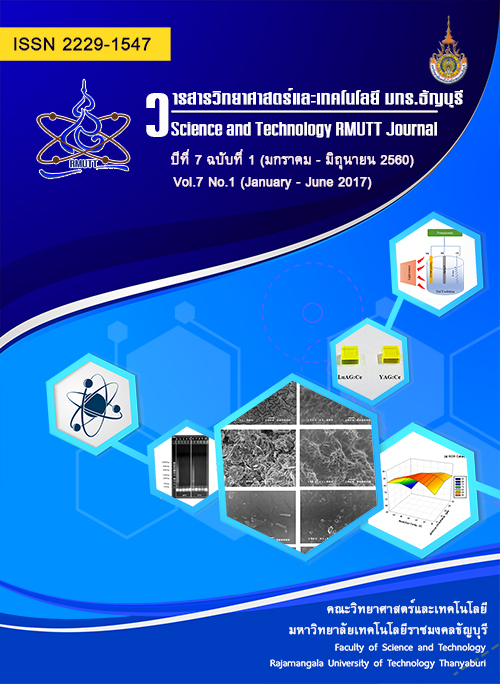Screening and Selecting of Exopolysaccharide Producing Lactic acid Bacteria from Fermented Thai foods
Main Article Content
Abstract
The 300-isolated lactic acid bacteria from fermented foods in Thailand were screened for exopolysaccharide (ESP) producing. The results found that isolated No. 23/14 derived from fermented subterranean ants in Lampang province could produce the highest amount of ESP which the maximum rate was 16.17 g/L. The API 50 CH kits and16S rDNA sequence were used for bacterial strain identification. The isolated No.23/14 showed the similar 16S rDNA sequence as Lactobacillus fermentum at 96.60% and 99.86% respectively. Six difference sugars (sucrose, glucose, mannose, fructose, lactose and xylose) were used for study the optimum carbon source for EPS producing. The best sugar could promote the highest ESP (1.33 g/L) as sucrose. Whereas, ESP yielded was about 0.36-0.45 g/L when using other carbon sources. Examination of monosaccharide composition in ESP produced from sucrose was analyzed by using thin layer chromatography, showed that the ESP was composed of rhamnose, glucose, mannose and fructose.
Article Details
References
Lilly, D.M. and Stillwell, R.H. 1965. Probiotics: growth promoting factors produced by microorganisms. Science. 147: 747 -748.DOI:10.1126/Science. 147.3659. 747.
Magnuson, T. S. 2011. How the xap locus put electrical “Zap” in Geobacter an exopolysaccharide producing Streptococcus thermophilus from Algerian raw cow milk. European Food Research and Technology. pp. 119 - 125.
ศิริพร หมาดหล้า, ภาวดี เมธะคานนท์, มาลินี ประสิทธิ์ศิลป์ และกัญญวิมว์ กีรติกร. 2548. คุณสมบัติของโพลิเมอร์จากเชื้อราในประเทศไทย และศักยภาพในการเป็นวัสดุปิดแผล. รายงานวิจัยในโครงการ BRT ครั้งที่9. ศูนย์พันธุวิศวกรรมและเทคโนโลยี ชีวภาพแห่งชาติ, สำนักงานพัฒนาวิทยาศาสตร์และเทคโนโลยีแห่งชาติ. กรุงเทพฯ. 111 หน้า
Patel, S., Majumder, A., and Goyal, A. 2012. Potentials of exopolysaccharide from lactic acid bacteria. Indian Journal of Microbiology. 52(1): 3-12. DOI 10.1007/s12088-011-0148-8.
Rendueles, O., and Ghigo, J-M. 2012. Multispecies biofilms: How to avoid unfriendly neighbors. FEMS Micro- biology Reviews. 36(5): 1-18 DOI: 10.1111/j.1574-6976.2012.00328.x
Paul De Vos, George M. Garrity, Dorothy Jones, Noel R. Krieg, Wolfgang Ludwig, Fred A. Rainey, Karl-Heinz Schleifer and William B. Whitman. Bergey’s Manual of Systematic Bacteriology. Secoond Edition. Volume Three. The Firmicutes. 2009.
Axelsson L. 1998. Lactic acid bacteria: classification and physiology. pp. 1-70. In Salminen, S. and Wright A. Lactic acid bacteria: microbiology and functional Aspects. Marcel Dekker, New York. 617 p.
Dubois, M., Gilles, K. A., Hamilton, J. K., Rebers, P. A. and Smith, F. 1956. Calorimetric method for determination of sugars and related substances. Analytical Chemistry. 28 : 350 - 356.
Miller, G.L. 1959. Use of dinitrosalicylic acid reagent for determination of reducing sugar. Analytical Chemistry. 31. 426 - 428.
Wang Q., Fang Y. 2004. Analysis of sugars in traditional Chinese drugs. Journal of Chromatography B. 812: 309-324.
Tipparat, H., Nantina, C., Santad, W., Sofia, K. and Robert A. R. 2012. In vitro prebiotic evaluation of exopolay-saccharides produced by marine isolated lactic acid bacteria. Carbhydr. Polym. 87: 846-852.
Saravanan, C. and Prathap K. H. S. 2015. Isolation and characterization of exopolysaccharide from Leuconostoc lactis KC117496 isolate from idli batter. International Journal of Biological Macro-molecules. DOI:10.1016/j.ijbiomac.2015.02.007.


